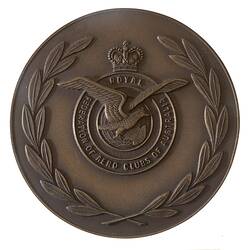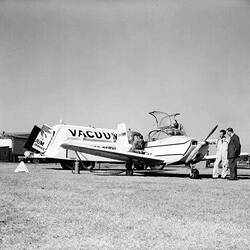The foundations of the Royal Federation of Aero Clubs of Australia were laid on 28 October 1914, when a group of young officers of the newly formed Australian Flying Corps met at Point Cook, Victoria. They decided that an Australian Aero Club should be formed, to be affiliated to the Royal Aero Club in London. The Australian Aero Club was formally constituted on 9 April 1915.
The Australian Aero Club was pre-dated by the establishment of an aero club and glider school in Brisbane, claimed to be the first in Australia, and soon renamed the Queensland Aero Club. In 1911 an Australian Aero Club was reported in the Albury Banner and Wodonga Express, which referred to 'balloon pilots and aeroplanists'.
The first President of the formalized Australian Aero Club was Major H.A. Petre, who had been sent out from England to inaugurate a flying school for the Australian Government. He chose a location at Point Cook, near Melbourne. The first Secretary, and later President, was Captain T.W. White, later to become The Hon. Sir Thomas White, K.B.E., D.F.C., V.D., who served with honour in both World Wars and became Minister for Air and Civil Aviation in the Menzies Government.
Just days after Petre and White were appointed both left for India with the Australian Aviation Corps (AKA Australian Flying Corps). Further development of the Club was delayed by World War I. In 1919 individual sections of the Australian Aero Club were formed in Victoria (the Australian Aero Club, Victorian Section), New South Wales, Queensland and South Australia.
In March 1926 the national aero club movement was formalised under the name of the Australian Aero Club Federal Council. It consisted of representatives of the Victorian and New South Wales Clubs. South Australia joined in 1927, Queensland and Tasmania in 1928, and Western Australia in 1929. That year a new Constitution was adopted, and the name changed to the Associated Australian Aero Clubs. In 1948 the name changed to the Aero Club Federation of Australia, and during 1960 the prefix 'Royal' was granted by Her Majesty and the title Royal Federation of Aero Clubs of Australia was adopted.
The primary object of the Clubs was initially to advance the cause of aviation throughout the Commonwealth. Aerial pageants and air races, flying displays and public receptions for pioneer aviators at the end of historic flights were enormously well attended.
As war began to threaten again in the 1930s, the Clubs began to realise their defence potential. They made strong representations to the Federal Government for financial assistance to support pilot training at a reasonable cost to the individual. When war broke out in 1939 several of the larger Clubs were turned into elementary flying training schools and provided the instructors, aircraft and ground maintenance facilities to train cadet pilots for the RAAF. This left the RAAF to concentrate on intensive instructor training.
After the war the Clubs trained National Service Air Training Corps Cadets, General Reservists, University Air Squadron Cadets and some Citizen Air Force Cadets. In later years the emphasis shifted from the training of pilots for defence purposes towards the training of commercial pilots for Australia's airlines, the rapidly expanding aerial agriculture industry and charter pilots. The RFACA introduced a low-cost scheme, the Airline Pilot Training Scheme, to fulfil these needs. Graduates are held in high regard by the airline industry.
Today a principal role of the RFACA is the representation of its members at Federal and State Government levels to encourage the establishment of training facilities and to promote the development of all aspects of private, sporting and recreational aviation.
References:
Royal Federation of Aero Clubs of Australia website http://www.flyingtraining.com.au/rfaca/rfacahistory.htm, accessed 21/4/2020.
Royal Victorian Aero Club website https://rvac.com.au/pages/rvac-history, accessed 21/4/2020.
AUSTRALIAN AERO CLUB. (1910, June 9). The Argus (Melbourne, Vic. : 1848 - 1957), p. 8. Retrieved April 21, 2020, from http://nla.gov.au/nla.news-article10862637.
AUSTRALIAN CORPS. (1911, January 10). The Argus (Melbourne, Vic. : 1848 - 1957), p. 8. Retrieved April 21, 2020, from http://nla.gov.au/nla.news-article10870222
UNCLE ALF'S EXPERIMENT. (1911, October 13). The Albury Banner and Wodonga Express (NSW : 1873 - 1938), p. 11. Retrieved April 21, 2020, from http://nla.gov.au/nla.news-article101165580
AUSTRALIAN AERO CLUB. (1915, April 12). The Age (Melbourne, Vic. : 1854 - 1954), p. 10. Retrieved April 21, 2020, from http://nla.gov.au/nla.news-article154955214
More Information
-
Keywords
-
Localities
-
Authors
-
Article types


